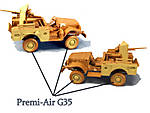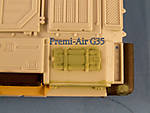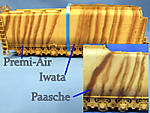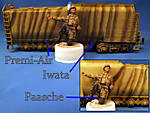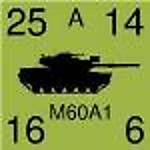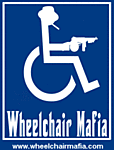1⁄1Airbrush Triple Treat Comparison
20
Comments
Premi-Air G35 Use
The outside is great, streamlined, and elegant. The first step was to see how the insides looked. I took it apart and it came apart easily. They provided a wrench for the nozzle and it came off easily. I would be extremely careful with this piece, as it is very small and loosing it will render the brush useless until it is replaced. The needle is incredibly fine and looks to be a machined really well. All the pieces came apart well and reassembly was easy. I did not notice any unwanted resistance.One things I noticed was a shallow cup. This means you will have to mix batches in a separate container: not necessarily a bad thing. It is an additional set of tasks to deal with. You'll need to mix and pour, and then clean the container and the brush. There is an added piece under the front end of the brush that runs down to the air valve. It give the brush a nice engineered flair. This is not where the function stops for this piece; more on this later. The trigger on this brush is a flat trigger with engraved 'grip grooves'. If the grooves grip there shouldn't be any slip. The connection to my air supply was easy and quick. There was no need for any extra connectors. Finger tight was good enough.
Spraying water through the brush was easy, smooth and consistent. The atomization of the liquid was very good. The resulting mist at full trigger pull and air flow was very good.
Test Patterns
I ran a batch of Tamiya Blue X4 through it. I used the same mix of paint water and a touch of dish soap. The goal was the same, draw lines and test the flow, control, and volume. The test sheet setup was the same, a piece of project paper wrapped around the same solid plastic plate. The air source was the same, 2 gallon tank on a compressor at 20 psi. With the size of the nozzle and needle on this brush couple with the small cup I wanted to test the detail nature of the brush. I tried as hard as I could to control the trigger in both directions to get a fine line. The action of the trigger was very responsive and firm. It didn't take much to get paint to come out and the quality and consistency of the flow was great. I didn't have to worry about the paint thickening or blotching. It came out even and consistent with the trigger action. As you can see from the test sheet the range of flow is pretty good. The small end (narrow) is great. The range is 1mm and up to about 5-10mm. Even at the top end of the spectrum the over spray was minimal which will reduce your need to mask.
Base Coat Test
The base coat test was another good one for the G35. I started concerned over the cups ability to hold enough paint; even for this small subject a Hasegawa Egg Plane. I again thinned down a batch of Tamiya light gray and applied a base coat to the subject. As with all previous G35 test the trigger action was good and paint response was solid. The spray pattern was adequate but not huge, so there were a number of passes. I was able to easily cover it with the paint from one cup size. The cup lid was actually a very nice feature. Having it on allowed me to tip the brush a bit more than with out it. This opened up getting in tight spots without moving the subject. The coverage was even, smooth, and constant. The atomization was good and the color dispersion was even. There wasn't a splotchy affect or a spider affect (yes part of this is a factor of paint thinness).
Subject Test
The bridge test was great. I sprayed the exact same areas as the Talon, just on the opposite side of the bridge. The control was exceptional and the resulting coverage was good. On the gap shadowing the thin nature of the spray was excellent. On the 1/72 scale car I was able to shoot the wheels without masking off the tires. No over spray to be concerned about, no problem, again a great application for this brush. These two tests used two different paints, Tamiya and LifeColor.
Camo Test
This test was the same as with the Talon, a 'quasi' realistic use of the brush to get thin tiger striping in multiple colors. The figure in the photo is a 1/35th scale resin figure, he's there for a scale reference.
I started with the same base of Tamiya Dark yellow. The first pass was the Model Masters Olivgrun Rlm 80 Green color. I tested the paint first to get a feel for the spray and flow. Once I was comfortable I sprayed a series of lines on the tender. With the Model Masters paint I had to slow my hand motion to get a good coverage. Moving to the Tamiya Red Brown I first sprayed out the green with some water and cleaner. Then once mixed I loaded up the brush and tested for thin lines. I ran into the same issue of the Tamiya paint being thicker and clogging the brush. With this brush it was very easy to (point at a test sheet) simply pull back on the paint flow and 'blow out' the paint. It was quick and easy to get back to the primary subject.
The results were easy to get this level of success.
Cleanup
Once used, you've got to clean up. I started by blowing some cleaner through it, then some water to make sure everything sprayed as clear as possible. Next I went ahead and disassembled the brush to clean all the parts inside and out. The needle was easy to remove as was the nozzle and nozzle cap. This allowed me to get a QTip into the paint tunnel from the cup, well as much as possible. The opening is very small and it was a bit tedious to do. The needle tip was VERY Small, be very careful with this. The size of the paint tunnel was the challenge with this brush. You can't use a QTip or rolled towel to thread through the holes, or dab out paint or thinner. Running cleaners through it and using a flat towel and capillary action was good enough to get the brush clean.
1. Spray Test YouTube Link
2. Base Coat Test YouTube Link
3. Bridge Test YouTube Link
Comments
Hi Scott,
Thank you for your effort - it was very interesting to read this review.
Just wanted to bring to your attention that Paasche is also offering fine nozzle/needle combination for the Talon. Please see the link here: LINK
I wonder if the Talon could show better results in terms of fine detail spaying with these ones.
Some idea: another airbrush worth looking at is Peak C-5 carried by bearair.com - it is made on Iwata's factory in Japan, has a 0.3 mm aperture and is basically a little bit altered old Iwata HP-C model with a needle travel adjusting knob thrown in.
Just for information of everybody, if you are interested in a more affordable airbrushes, you can look at PrecisionAire at Bear Air, Master airbrushes at TCP Global at LINK, and Airbrushcity Airbrushes at LINK
You can find affordable air compressors at LINK
In none of the cases I cannot comment on the quality.
HTH,
Regards,
Doncaster
NOV 08, 2008 - 04:07 PM
must say im quite geard towards getting the premi-air for xmas, anythings better than me old badger, plus for 100 £ i get a compressor with it
NOV 11, 2008 - 08:38 AM
I'm currently using the Paasche VL double action airbrush. It is a good tool, though there are several things I dislike about it, including the open gravity cup (moving about I have spilled a lot of paint!), the fragile needles that are often damaged by the need to remove them for cleaning (spraying any clear acrylic, for example, gunks it up big time), and the lack of any instruction manual that has left me to figure most things out for myself.
The three airbrushes reviewed here are all similar, but I noticed the Iwata is an entry-level product. I. I am interested for recommendations on something for a more-advanced modeler, though I can see the Paasche is supposed to cover the gamut. I know the Iwatas are admired, but I don't know which model would be best.
FYI I'm using the Paasche D500 30 psi compressor which seems fine with the airbrush I'm using.
NOV 11, 2008 - 08:50 AM
Hey guys
Can someone tell me if this is true, the rumors i have heard are that the Talon cannot shoot enamels? I really liked the look of the Talon and down the road was thinking about getting one but i use strictly enamels only.
Thanks in Advance.
Jerry
JAN 02, 2009 - 05:03 AM
Nice artical. However he did not mention that you can get the Iwata Revolution with a larger cup size and a .5mm nozzel for painting larger areas. I use mine for base coats and an Iwata HP-C for my fine work.
MAR 10, 2012 - 05:06 PM
That's a great article. One question, how would you evaluate the G35 for larger scales/areas to cover?
Matt
MAR 11, 2012 - 01:53 PM
I've been using a G35 for ages and I find it covers large areas with ease. The paint cup isn't too large though, so if you are doing a ship or a big base or something then a couple of re-fills will be needed but the actual spraying is brilliant- it is a real workhorse of an AB.
MAR 12, 2012 - 01:02 AM
Hi Matt,
I've got a G35 and use it for all my 1:35 tanks. It can take multiple passes to cover big areas, but then again I tend to "layer" my paint in thinned coats anyway to get some tonal variation so it's ok if I fail to get a good overlap. However, where I've needed a good solid coat it did the job well enough. If you're doing really big stuff and need to solidly cover more than a half-inch-wide stripe with each pass you'll probably need an external-mix firehose like the old Badger 350 that I also have.
Hope this helps!
Tom
MAR 12, 2012 - 01:10 AM
I may have to get one. My Badger is beginning to break down and I've been looking for a solid, reliable airbrush for basic use as a replacement. That prices is awfully hard to beat!
Matt
MAR 12, 2012 - 02:10 AM
Copyright ©2021 by Scott Lodder. Images and/or videos also by copyright holder unless otherwise noted. The views and opinions expressed herein are solely the views and opinions of the authors and/or contributors to this Web site and do not necessarily represent the views and/or opinions of Armorama, KitMaker Network, or Silver Star Enterrpises. All rights reserved. Originally published on: 2008-11-04 00:00:00. Unique Reads: 62234




